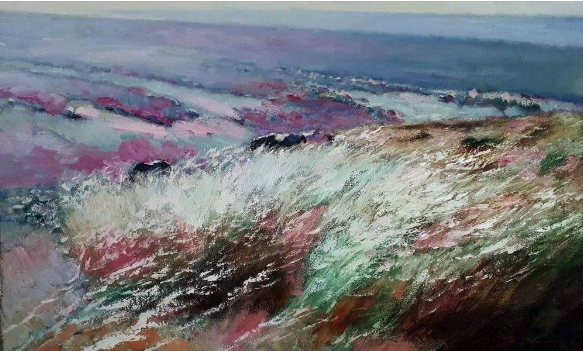Our mind is often too preoccupied with important issues. Many incidences of misplaced smartphones, wallets or keys can be blamed on our excessive attention to big problems. Not being able to find our smartphone can cause us to panic. But after wasting precious time in search for our belongings, we are often pleasantly surprised to find them in unexpected places. Before carrying on with our day, it might be helpful to recognize, after laughing at our own silliness, that behind destiny’s cruel little trick lies an important reminder, one as significant as our vision for the future: paying attention to what is in front of us is a crucial practice in our pursuit of greater endeavors.
Of course, not all tricks in cultivating our appreciation for the present moment have to be as shocking as a missing smartphone. Viewing landscape art can be a productive and less stressful way of exercising mindfulness. Through the artist’s sustained observation of nature’s colors under various conditions, such paintings can reveal to us the quiet beauty in seemingly mundane evidences of the passage of time.
Mongolian impressionist painter, Honored Cultural Figure Ts. Narangerel, specializes in open air (plein air) paintings that seem to transmit the evanescent aura of nature with spontaneous fluidity. Vivid colors applied with clearly visible quick brush strokes give the impression of effortless execution; while the free use of diagonal demarcations in the composition bring a unique perspective on the subject matter. The resulting imagery is both soothing and refreshing to the eye. In Narangerel’s paintings, a rock-strewn snowy mountain comes alive with a myriad shades of pink against a clear-blue morning sky; a lavish summer forest luminesces with an emerald glow in the reflection of a mountain lake; a soft autumn wind caresses the horses peacefully grazing in a mauve, cream colored pasture; a young mother nurses her baby in the small shade of her ger, while her older child and a sleeping dog keep her company in the silent heat of a Gobi afternoon, their camels having been herded away from their calves, who presently stand tethered to their post, longingly listening to the mother’s gentle lullaby.

Narangerel’s depiction of idyllic atmospheres such as these is a skill that was acquired over the course of more than 40 years. Encouraged to become an artist by his father, a construction engineer from Tuv Province, Narangerel began in the 70’s as one of eleven students of People’s Artist L. Gavaa, famous stage designer and painter, who taught him how to learn to draw and to practice by drawing from nature, which helped develop his technique. In the 80’s, he pursued his studies in applied arts at the Academy of Arts, Architecture and Design in Prague (UMPRUM), which many of his earlier more decorative and post-impressionistic works attest. He taught his craft in the art schools of Mongolia for over 25 years. Throughout his long career, painting in the plein air of Mongolian countryside has been a great source of inspiration for Narangerel’s artwork.
In plein air, nature’s colors change quickly from moment to moment. The instant a painting is being born is different from the one in which it is complete. So in painting fast, the memory learns to quickly absorb as much information as possible in order to recall it later when finishing the picture inside the studio. That is why no two paintings are alike even if the subject is the same — every passing minute is a treasure to behold. “Sometimes I feel as if a higher power is dictating my hand to execute an idea,” Narangerel said, “When I take a look at my finished work, I am often surprised by the outcome as I do not remember how I did it.” For example, autumn in its multifaceted memorable qualities is a frequent subject in Narangerel’s work.

In Yuruu Gol, the water is starting to freeze into a thin layer of ice that reflects the sky with an azure-blue shine; in Ankhny Tsas, the first snowfall of the year is festively welcomed by the contrasting crimson foliage of shrub; in Oroin Nar, the sunset illuminates a saffron mosaic of tree branches reflected in the crystal-rose colored river in the foreground. Most of his paintings are completed within 20 minutes as maintaining sustained attention in plein air also requires alertness and a fresh set of eyes. Perhaps that is why his paintings are smaller in size and look like sketches when seen upon close-up. Nevertheless, they are evidences of his ability to sincerely capture the ephemeral moments of nature on canvas. “Painting in plein air is like getting to know your pet, the more time you spend with nature the more you can predict her moods in a certain hour of the day in a particular season. I keep learning from nature,” said Narangerel, “Nature is the most generous teacher there is.”
Plein air paintings teach us how to be fully present in the now. In capturing on canvas nature’s transformations so inconspicuous that we might not notice them in our day to day commotions, Narangerel shows us the subtle power of art that nourishes our patience and restores our sense of harmony, balance and contentment. His paintings remind us that we too are a part of nature and are lovingly accepted by her just as we are, with all our flaws and worries. Therefore, contemplation of nature, together with and through art, can give us a much needed pause, before we set forth with our smartphones toward our next summit of achievements, and acknowledge that where we are today in life is not all that bad; that who we are and what we have is quite enough for now.



By Ariunaa Jargalsaikhan
Published in UB Post on April 15th, 2020 Ulaanbaatar








